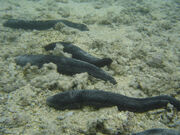| ||||||||||||||
The Trieste fish was a cryptid deep sea fish seen once, in the Challenger Deep, the deepest known point of the Mariana Trench in the Pacific Ocean, during a descent by the bathyscaphe Trieste↗ on 23 January 1960. The pilots of the Trieste identified it as a flatfish (order Pleuronectiformes), a supposition received with strong negativity by the majority of marine biologists, as vertebrate animals have never otherwise been recorded from such great depths.[2][3]
Sightings[]
1960[]
On 23 January 1960, the deep-sea research bathyscaphe Trieste, piloted by Jacques Piccard (1922 – 2008) and Lieutenant Don Walsh (born 1931), made a descent into the Challenger Deep of the Mariana Trench, the first successful manned expedition to this deepest region of the ocean. The actual depth at which the Trieste reached the seafloor is debated, but it was somewhere around 35,000–36,000 ft (10,668–10,972 m). Piccard later wrote that, when the Trieste made a bumpy landing on the seafloor, he observed what he described as a sole-like flatfish from the window.[1]
| “ | As we were settling this final fathom, I saw a wonderful thing. Lying on the bottom just beneath us was some type of flatfish, resembling a sole, about 1 foot long and 6 inches across. Even as I saw him, his two round eyes on top of his head spied us – a monster of steel – invading his silent realm. Eyes? Why should he have eyes? Merely to see phosphorescence? The floodlight that bathed him was the first real light ever to enter this hadal realm ... Slowly, extremely slowly, this flatfish swam away. Moving along the bottom, partly in the ooze and partly in the water, he disappeared into his night.
|
” |
Theories[]

Piccard believed that he had seen a flatfish similar to a sole (CC BY-SA 3.0).

Most marine biologists believe it was something like a sea cucumber, which may look fish-like (CC BY-SA 2.0 FR).
As of 2019, the accepted record for the deepest known fish is held by a species of cusk-eel named Abyssobrotula galatheae, which may live as deep as 27,460 ft (8,370 m),[3] although the accuracy of the depth has been questioned. Other than this species, the deepest-dwelling seafloor fish known are the snailfishes, small tadpole-shaped fish. The Mariana snailfish (Pseudoliparis swirei) has been observed as deep as 26,496 ft (8,076 m), and the undescribed ethereal snailfish is known from slightly deeper waters.[4] The alleged Trieste fish was osberved some 10,000 ft (3,048 m) deeper than these record-setting fish. Another point of contention was the fact that the fish was alleged to have eyes, which, as Piccard had noted, would be seemingly useless in such pitch-black water.[2]
For these reasons, many marine biologists immediately rejected Piccard's identification of the animal as a fish.[3] Torben Wolff argued that Piccard had most probably seen an eyeless sea cucumber (class Holothuroidea), possibly one of the oval-shaped species Galatheathuria aspera.[2] Walsh, who stated that Piccard and not he had seen the flatfish, later admitted that the animal may not have been a fish, as the sediment stirred up by the Trieste made it difficult to see, "like looking in a bowl of milk," and "[n]either Jacques nor I were trained biologists ... the critter could have been something else."[5]
Notes and references[]
- ↑ 1.0 1.1 Piccard, Jacques & Dietz, R. S. Seven Miles Down (1961)
- ↑ 2.0 2.1 2.2 Eberhart, George M. (2002) Mysterious Creatures: A Guide to Cryptozoology, ABC-CLIO, Inc., ISBN 1576072835
- ↑ 3.0 3.1 3.2 Jamieson, Alan (2015) The Hadal Zone: Life in the Deepest Oceans
- ↑ Linley. T. D. et. al. "Fishes of the Hadal Zone Including New Species, in situ Observations and Depth Records of the Liparidae," Deep Sea Research Part I: Oceanographic Research Papers (2016)
- ↑ Barton, Adrian "Way Down Deep," Frontiers in Ecology and the Environment, Vol. 10 (2012)
